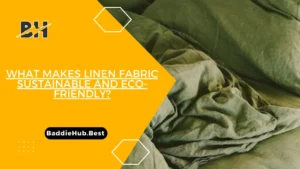What Makes Linen Fabric Sustainable and Eco-Friendly?
Linen fabric is produced by using very environmentally friendly methods. Linen fabric has an appropriately long history, tracing back thousands of years, and its journey reflects a commitment to sustainability. Linen requires less than most others, including less water and pesticides, and the linen fibres are completely biodegradable.
T & A Textiles wholesale household linen shows how we can support the trend for more sustainable textiles. High-quality linen products offered at the same time reflect their commitment to green practices. Such linen fabric represents a historical contribution to modern eco-awareness and is one of the favourite choices for people who try to live a more responsible life. In this article, we’ll get you through the reasons which make linen fabric sustainable and eco-friendly.
Cultivation Practices of Flax:
Understanding how flax is cultivated helps to outline why linen fabric production can be so sustainable. Flax can thrive in a wide range of climates; this reduces the need for extensive irrigation, thus preserving water resources. This ability of flax to put up with different growing conditions makes it an excellent choice for environmentally conscious consumers. Farmers can grow flax without relying on artificial inputs to a great extent and that makes flax a more organic alternative for fabric production. It is also adaptable to areas where other crops would not be able to survive, therefore minimising the application of water and chemicals.
Reduced Application of Pesticides:
Flax requires a great deal less pesticide use compared to many other crops. This lessens not only toxic chemical runoff to the local ecosystem but also to its soil and water, further promoting biodiversity. The reduced use of pesticides also trickles down on the flora and fauna nearby, thus ensuring that ecosystems are not out of balance. It follows that linen fabric production is a supporting contributor to environmental health and sustainability, and therefore responsible, in light of the ecological impact of its production.
Minimal Water Requirements:
There are several standout sustainability features for linen fabric, but one of the important factors is that it has quite minimal water usage. Compared to crops like cotton, which are notorious for their water usage, flax plants require far less. This efficiency is very important, especially where there is a shortage of water. Indeed, water is one of the most important resources whose conservation by growing flax helps to save and eventually reduces the demand placed on already strained local water supplies. Because of its water efficiency, linen fabric is also a good option for sustainable agriculture. Unlike fabrics that require huge volumes of water, linen contributes positively toward prudent water management and reduces the ecological footprint of textile manufacturing.
Biodegradability:
Linen fabric degrades without much hassle, unlike synthetic fabrics that take hundreds of years to decompose in landfills. On the other hand, when linen products are thrown away, they can easily decompose and return to the earth, and long-term harm does not occur to the environment. This is suitable for a circular economy whereby one intends to design materials to be safely reabsorbed into the ecosystem. This fabric can perform its natural decomposition without releasing any harmful substances in contrast to what usually happens with synthetic materials.
Reducing Waste:
Linen textiles decompose more quickly compared to their synthetic counterparts; this means less contribution to landfill waste over an extended period. Consumers who use linen participate in an approach that is more sensitive toward waste management. It will lessen the burden on landfill sites and consumer responsible habits. The natural decomposition of linen contributes to a circular economy whereby the resources will be used with utmost efficiency and very minimal production of waste.
Conclusion:
Linen fabric stands tall as a sustainable attribute because of its efficiency in resource utilisation and eventual natural disposal. Linen is one of the eco-friendly materials as it decomposes faster than others. Every man can help in building a better future toward sustainability and ecological balance by choosing linen for a greener textile industry.















